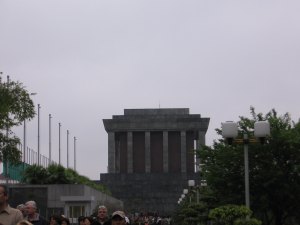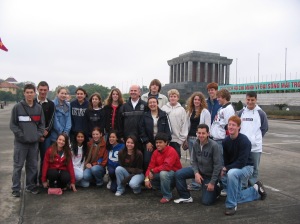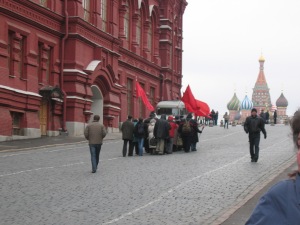I remember an old friend from High School telling me that he had seen a dead body while he was living in Yemen. He asked me at the time if I had ever seen a dead body before.
It happens that I have seen two in my life. Two dead bodies that belonged to two famous revolutionaries.
March 2006:
I’m with my tour group and the tour guide, David Eales in the centre of Ba Dinh Square. It was here that Ho Chi Minh, then leader of the Vietminh, read the Proclamation of Independence of the Democratic Republic of Vietnam on September 2, 1945 believing it to be the opportunity for Vietnam to declare independence from France. This officially led to the creation of North Vietnam at the end of World War II.
The rules are strict. No digital cameras or camcorders are allowed in the mausoleum. Same with food and drink. Visitors have to form two straight lines and observe a dress code. No shorts or miniskirts are allowed and arms must be kept straight with hands out of one’s pockets.
The lines shamble along, doing with their eyes what cameras and video cameras would have done in an instant. A military honour guard stands watch over the glass case, dimly illuminated by white lights. From nine in the morning to midday, the embalmed body is available for viewing to the public. The rest of the time, the mausoleum is closed in order to maintain the preservation of the former leader’s body.
It’s a macabre sight at the best of times. What makes it worse is that Ho Chi Minh didn’t want it to happen. According to historians, he wanted to be cremated, his ashes spread across the north, south and centre of the country. A grand mausoleum was considered a waste of arable land to him.
The mausoleum is inspired by Lenin’s own resting place in Moscow’s Red Square. Unbeknownst to me, I will have the opportunity to see him as well in the near future.
March 2007:
The air of March is perfectly tolerable for the average Russian. For a group of students who just came from Cairo, it feels good to be bundled up. Our guide Michael takes us to Red Square where the tomb of Vladimir Ilyich Lenin continues to draw tourists and remnants of the Communist Party in Russia.
Just like Ho Chi Minh’s tomb, it is forbidden to take photos or record the moment on video. Everyone marches in single file around the glass case where the revolutionary lies to this day. He lies on his back with his black suit still on him. Despite all the rumours that his corpse was replaced by a wax dummy, I still dread the moment where his eyes open. I’ve got one foot in a reverie and another on the floor of a darkened room where the same man who created the Soviet Union has been lying in state ever since he died, years before anyone in the room was born. But I can’t stay in my head for too long with the guards ushering us out of the building.
The daylight brings us back to the world of the living once more.
It’s been about five to six years since I last saw them. But one thing is for sure. I can say with certainty that I’ve seen a dead body in real life. And not just anyone’s body.
As far as bragging rights go, I’m not sure how to feel.


